Menu

Despite strict safety rules, accidents with heavy machinery still happen. Why is this?
Heavy machinery is vital in many building projects. It’s crucial to use them safely. Incorrect use can cause severe accidents like rollovers or getting caught. To have a site without accidents, a strong safety plan is needed. This includes training for operators, knowing what’s around you, using the equipment carefully, checking it before use, and following maker’s guidelines. Focusing on these steps ensures safety and keeps everyone on the site safe.
Safe use of heavy machinery is key to reducing workplace accidents. A big risk is getting hit by a machine, which accounts for many work-related deaths. So, it’s critical to have strict machinery safety precautions in place to stop these events.
The Occupational Safety and Health Administration (OSHA) and safety experts warn about the dangers of heavy machinery. They say that risk checks and knowing the dangers are important. It’s also vital to train equipment users well to lower accident chances, making operating equipment safely a top concern.
Managing how equipment is used is crucial too. By putting rules in place, workers are more likely to follow machinery safety precautions. Regular maintenance is a key measure to prevent accidents from mechanical issues.
Seeing well is another big issue. Good lighting for work at night improves safety a lot. Workers on foot must stay out of machine blind spots. This means they need to follow machinery safety precautions carefully too.
Spotters play a huge part in keeping everyone safe. They know how to signal to machine drivers, stopping accidents from blind spots. Together, all these steps help make the workplace safer and more efficient.
Proper training for equipment operators is key for heavy machinery safety. It ensures they work safely and productively. A thorough training plan is essential for their skill and safety.
Operators learn about safety, hazards, how to use equipment, and the right ways to operate it. They get certifications like OSHA 30 and for specific machines. This means they can work safely and well with heavy machinery.
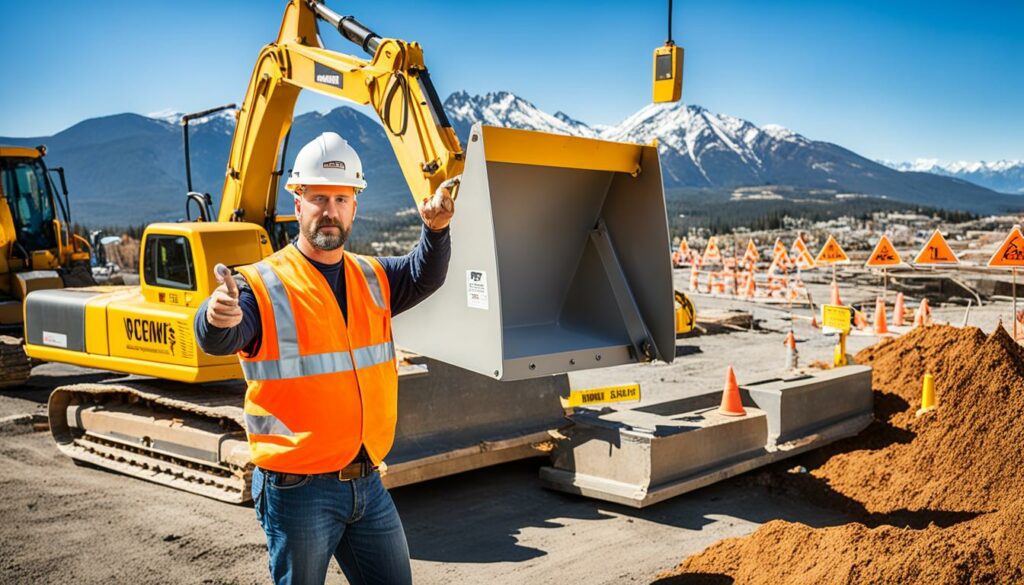
Training mixes lessons in a classroom with practical work. Operators get to know the machinery they’ll use. The course lasts six weeks to cover everything they need to know well.
| Certification | Description |
|---|---|
| OSHA 30 Certification | Ensures familiarity with regulations and standards for safe equipment operation |
| Excavator Operator Certification | Training on the safe use and handling of excavators |
| Forklift Operator Certification | Instructions on operating forklifts safely within various environments |
Ongoing learning is just as important as first-time training. Refresher courses keep operators up-to-date. This is crucial for new safety rules or if someone’s not working safely. Some students can get help to keep learning and getting certified.
Summing up, thorough training is vital for machinery safety. By combining theory and practice with refresher courses, safety and efficiency are maintained. This reflects the best ways to work with heavy machinery.
Being safe around heavy machinery starts with good planning and safe work habits. These steps make sure the work area is safe, stopping accidents and keeping everyone safe.
Before starting any construction, you must look for risks and hazards. Then, put up rules to avoid the dangers of using big machines. These rules include how to use machines safely and keeping vehicle movement low to reduce risks.
Making safe work habits means teaching those who use the machines about risks. It includes wearing bright clothes, keeping the machines well-maintained, and following safety rules. Doing this lowers the chance of people getting hit, a big cause of accidents.
Planning where machines and people move is very important. It avoids accidents from falling items or machines not being seen. Talking every day about where work happens and where machines are keeps everyone alert.
| Key Practice | Description |
|---|---|
| Administrative Controls | Administrative controls are implemented to minimize risks associated with heavy equipment. |
| Training | Providing comprehensive training for equipment operators in hazard awareness and safe operation techniques. |
| Equipment Maintenance | Maintaining machinery in good operating condition to prevent accidents. |
| Lockout/Tagout Procedures | Utilizing lockout/tagout procedures to ensure safe maintenance practices. |
| Limited-Access Zones | Establishing restricted zones around heavy equipment to enhance safety. |
Following these steps daily makes work sites safer. A good plan and strict safety rules help everyone avoid accidents.
Checking heavy machinery before each use is crucial for workplace safety. It’s not just suggested; it’s a rule from the Occupational Safety and Health Administration (OSHA). This check involves looking at the equipment every day and making sure it works well. Doing this helps in spotting problems early, preventing bigger issues.
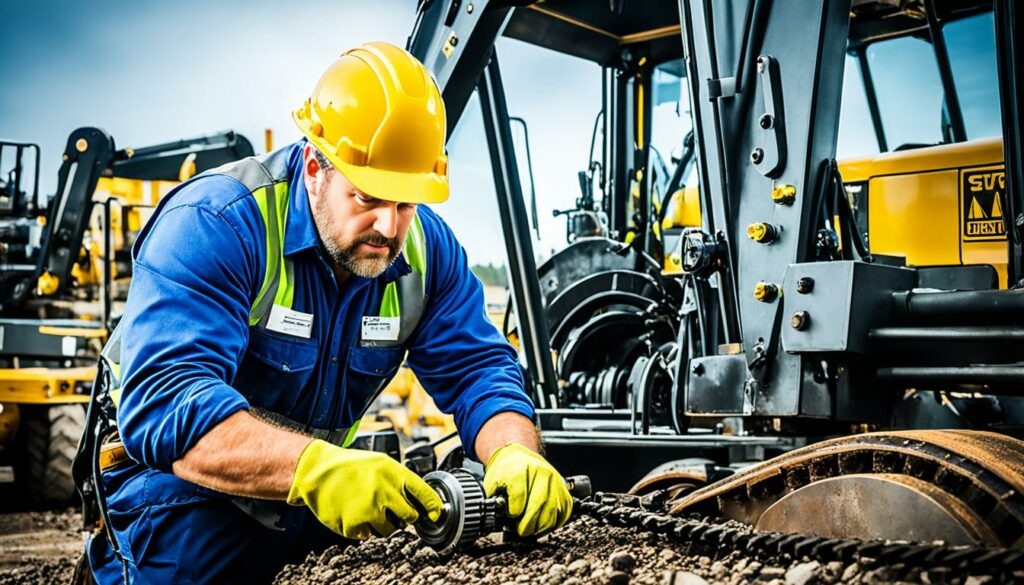
Looking at the machinery every day helps in finding any wear or damage. Operators should check things like hydraulic systems, controls, and braking systems closely. This helps keep everyone safe on the construction site. Daily checks also make sure the machinery lasts longer.
Functional checks go beyond just looking at the machinery. They include ensuring fluid levels are right and that equipment parts are safe. A checklist is used to check all parts of the equipment. Important checklist items are the date of the check, who did it, and the condition of the equipment.
By following these tips, operators can avoid accidents and machine harm. Inspections help keep the work going without trouble. They lessen costs by reducing repairs. Sometimes, getting help from experts for detailed checks is a good idea. Their knowledge can lower the risk of machine failures.
| Inspection Type | Key Focus Areas | Benefits |
|---|---|---|
| Daily Visual Inspections | Hydraulic systems, blades, controls | Immediate identification of wear & damage |
| Functional Verifications | Fluid levels, attachment integrity, safety features | Ensures operational capability and safety |
Wearing a seatbelt is not just a rule you have to follow. It is essential for safety, as shown by Caterpillar’s research. It proves that people who wear seatbelts are more likely to be safe in serious accidents. These include rollovers, tips, and sudden stops.
Strict safety rules include wearing your seatbelt while the machine is on. This is highlighted by warning codes such as E1388. They sound if the seatbelt is not on and the machine is not idle. The warning lasts for up to five minutes. If the seatbelt is still not put on, a more serious warning, E1434, comes next.
Caterpillar believes that using a seatbelt is crucial for staying safe. Wearing a seatbelt can lower your risk of getting hurt by 45%, says the National Highway and Traffic Safety Administration. Shockingly, 40% of deaths at work happen because of car accidents, according to the Bureau of Labor Statistics. Not wearing a seatbelt can also break the law. This might lead to fines and stop work from getting done.
Many work places insist on seatbelt use to prevent accidents. The Centers for Disease Control and Prevention say these accidents cost more than $45 billion each year. In 2014, over 600 people died in accidents with heavy machinery. And 25% of these deaths happened because they weren’t wearing seatbelts.
In the US, 34 states and the District of Columbia have strict seatbelt laws. Fifteen have less severe laws. Federal rules say if a commercial vehicle has a seatbelt, you must wear it. Even with all these rules, only 54% of big truck drivers actually do. It is vital for everyone in the heavy machinery industry to follow these safety rules. They are important for protecting workers and keeping work going.
When you work with heavy machinery, staying aware can reduce risks and make things safe. Always watch out for dangers and talk clearly with spotters. This keeps the work area safe.
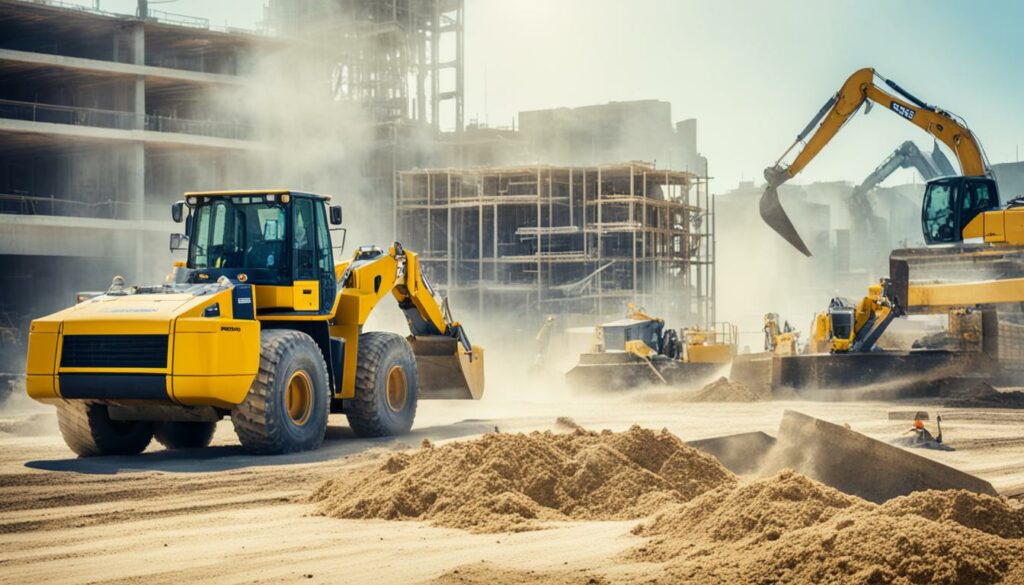
Looking around carefully helps cut down on injuries. Getting hit by equipment is a big risk on building sites, causing many deaths. Things like things falling or not being seen clearly are big dangers. It’s key to spot these dangers early on.
Having spotters is crucial for working safely around heavy machines. Skilled equipment operators who are also spotters can make the job safer. Spotters need to wear bright clothes and know how to use hand signals. This helps them direct the equipment operators well and keep people out of danger zones.
Heavy machinery safety tips underline how spotters make things safer on site.
Blind spots are a big issue with heavy machinery. Accidents often happen because the operator can’t see everything. Making sure mirrors are set right and that everyone knows about blind spots helps avoid crashes.
| Safety Measure | Outcome |
|---|---|
| Daily Equipment Inspections | Reduces malfunction risks |
| Maintaining Three Points of Contact | Minimises fall injuries |
| Spotters for Blind Spots | Enhances site safety |
| High-Visibility Clothing for Workers | Improves worker visibility |
Following these heavy machinery safety tips is crucial for a safe workplace. Operators need to stay alert, work with spotters, and be aware of all the risks that come with using heavy machines.
Being safe around heavy machinery means taking great care when getting on or off. It’s vital to follow safety guidelines closely to prevent any injuries.
There’s a key rule for safe use of heavy machines. It’s called the three points of contact rule. This means having three parts of your body touch the machine as you step on or off it. Doing this helps keep you balanced, reducing the chance of falling off.
Operators should use two hands and one foot, or two feet and one hand. They should do this until safely on the machine, or down on the ground. And don’t carry stuff when climbing.
It’s very important to stay away from machinery that’s moving. Never get on or off a machine while it moves. Make sure it’s fully stopped and secure before you step. Look around to avoid walking into the path of other machinery movement.
Always keep an eye out, and use a helper if needed for safety. This way, you can be sure the machine’s surroundings are clear before you move.
On construction sites, good communication keeps everyone safe. It ensures machinery is handled properly and dangers are avoided. Clear and consistent talking stops possible accidents.
Using radios between workers and those on the ground is vital. It gives instant updates on machine movements. This makes everyone more aware and ready to act fast against any danger. Radios should be looked after well and used properly to prevent mistakes.
Hand signs play a key role when noise stops people from talking. Both equipment operators and spotters need to know these signs well. It helps them guide the machines safely. This is very important for keeping work sites safe.
Making sure workers can see around big machines is very important. Areas where they can’t see can be very dangerous. Keeping the work space well-lit and clear of things helps a lot. Using mirrors, cameras, and spotters can reduce the risks greatly. This follows the rules on how to use big machines safely.
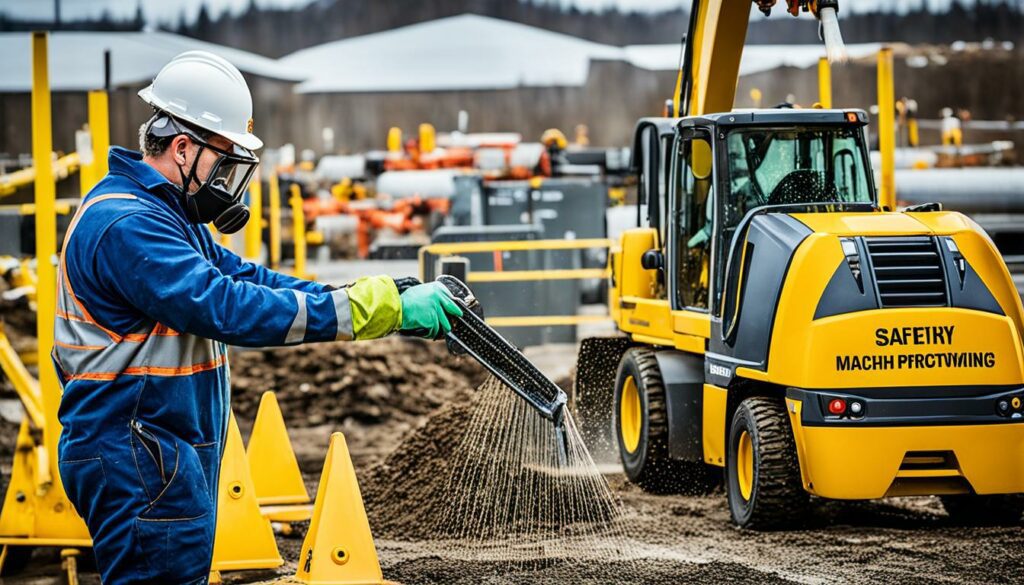
| Communication Method | Benefits | Best Practices |
|---|---|---|
| Radio Communication | Real-time updates, immediate responses | Maintain equipment, follow strict protocols |
| Hand Signals | Non-verbal communication, effective in noisy environments | Standardisation, thorough training |
| Clear Visibility | Minimise blind spots, enhance operator awareness | Use mirrors, cameras, and spotters |
Using personal protective equipment (PPE) is key to staying safe while working with industrial equipment. PPE creates a shield against many dangers, such as chemicals and machinery. It includes things like gloves, glasses, boots, and hard hats.
Safe industrial equipment operation relies on well-designed and comfortable PPE. When gear is comfortable, workers wear it more. This reduces their risk from hazards. Employers must train their workers on PPE use and maintenance.
PPE is vital when other safety measures aren’t enough. OSHA requires its use to keep workers safe. Following OSHA and ANSI standards is crucial for a safe workplace.
Every organisation should have a strong PPE programme. It should include risk checks, choosing the right PPE, training workers, and checking that it works. In construction, using PPE correctly can lower dangers and improve safety.
Lockout/tagout (LOTO) procedures ensure safe maintenance practices. They keep workers safe from sudden machinery start-ups and stop the release of dangerous energy. This is essential for anyone servicing machinery.
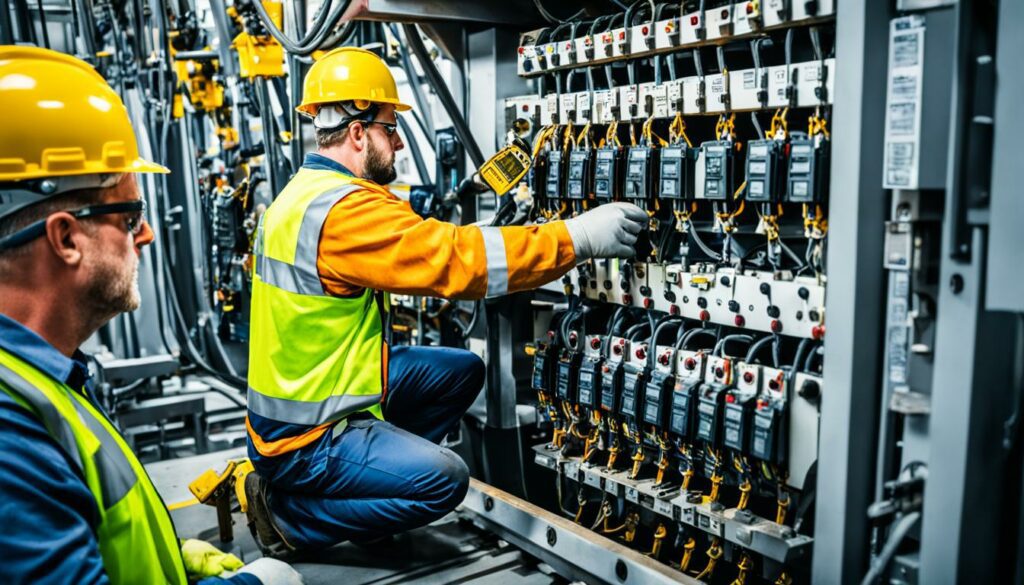
OSHA says LOTO is vital for guarding people from harmful energy. This energy can come from electricity, air, chemicals, and more. Without LOTO, maintenance work could lead to accidents or even deaths. That’s why everyone working with machinery should know these safety rules well.
LOTO aims to shut down machinery completely during maintenance. It focuses on eight main steps for a safe environment. Every organisation must make sure these steps are part of their safety culture.
When maintaining equipment, all energy sources must be controlled. Locks at the shut-off points should be strong and tags clear. These tags need to warn clearly against starting the equipment. They should be fixed with unbreakable materials, like a nylon zip tie. This ensures the warning can’t be easily removed.
In group lockout situations, each worker has their own lock. There is also a lockbox for shared keys to prevent mix-ups. Shift changes require extra care to make sure the lockout continues uninterrupted. This helps keep everyone safe.
| Criteria | Details |
|---|---|
| Annual Safety Impact | Prevents an estimated 120 deaths and 50,000 injuries (OSHA) |
| Energy Sources Controlled | Electrical, Hydraulic, Pneumatic, Mechanical, Chemical, Thermal |
| Mandatory Components | Locks, Tags, Non-reusable fasteners |
Following machinery safety guidelines makes maintenance safer and the work more efficient. Detailed training, right tools, and sticking to LOTO all help. They create a work setting that’s both safe and productive.
Keeping your work area clear is vital for operating heavy machinery safely. When there’s enough space around machinery, accidents are less likely. At the same time, work flows better.
Barriers around heavy machinery reduce the chances of people getting too close and getting hurt. They remind workers to stay a safe distance away. This makes the whole area safer. Barriers show where it’s safe and where there might be danger, like near moving machinery.
Blocking off areas where machinery is in use is crucial. It helps keep everyone safe, including those not running the machines. By using signs and barriers, we keep people out who aren’t trained. This means only skilled workers are near the dangerous equipment.
This method, combined with teaching how to work safely and keeping up with it, makes work sites much safer. It creates a safety culture where everyone is more aware.
Pre-planning projects with trained equipment operators and spotters and using barriers and clear signs can greatly cut down accidents. This makes it a really important step for safety at work.
It’s vital to follow the maker’s instructions when using heavy gear. This helps keep everyone safe and work running smoothly. Ignoring these rules might cause the gear to break, accidents, or serious harm.
One top tip for heavy machinery safety is sticking to what the manual says. These instructions help make sure the equipment is used correctly and safely. They cover how to look after it, when not to use it, and what to do in emergencies. Not following these can put the gear and the person using it at risk.
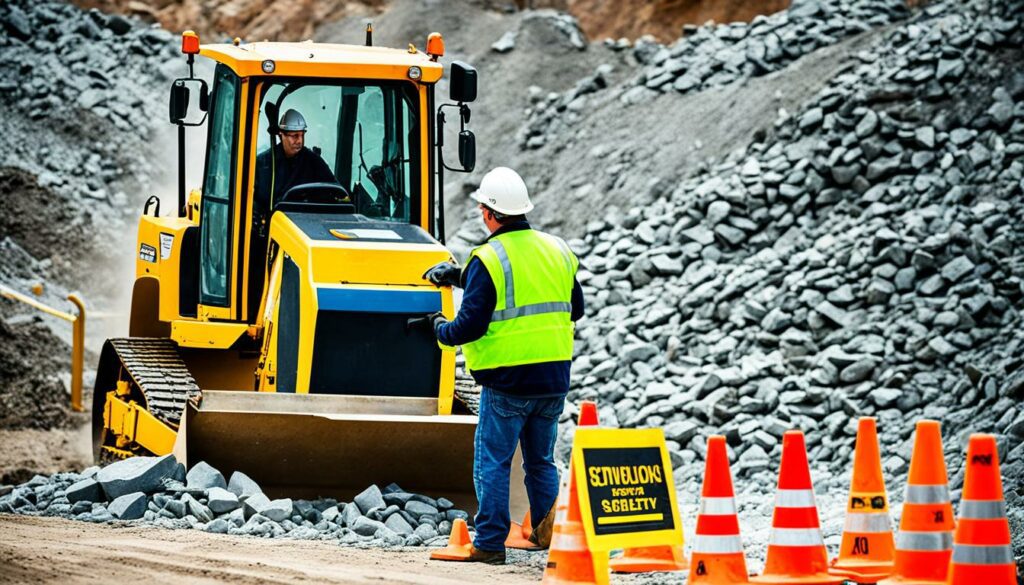
Never overload machinery – it’s a key best practice. Every piece of machinery has a limit to what it can carry or lift. Going over this limit can have very bad results. It could stress or spoil essential parts, possibly stopping the machine from working suddenly. Always check that you’re not carrying too much to keep it all running safely.
Keeping ground workers safe around big machines is crucial. Wearing the right clothes and working in safe areas helps avoid accidents.
Ground workers always need to wear high-visibility clothing. This makes them easy to see around moving machines. It cuts down on their chances of getting hurt by heavy equipment. Many accidents happen when workers aren’t seen well, and these are often deadly.
Setting up clear work areas is very important. It stops workers from getting too close to dangerous equipment. By planning this out and making sure everyone knows the rules, accidents drop. It also makes workers more careful in general.
A table below shows how effective these steps are:
| Safety Measure | Benefits |
|---|---|
| High-Visibility Clothing | Reduces risk of “struck-by” accidents |
| Designated Work Zones | Minimises interaction with heavy machinery |
| Regular Training | Increases awareness of safe practices |
| Use of Spotters | Enhances communication and safety |
Using these safety steps every day makes the work environment safer. It helps ground workers and machine operators do their jobs with less risk. The site becomes safer and runs better.
It’s vital for operators and spotters to work together when using heavy machinery to stay safe. They must always watch out for blind spots. And, they need to communicate well to lower the risk of accidents.
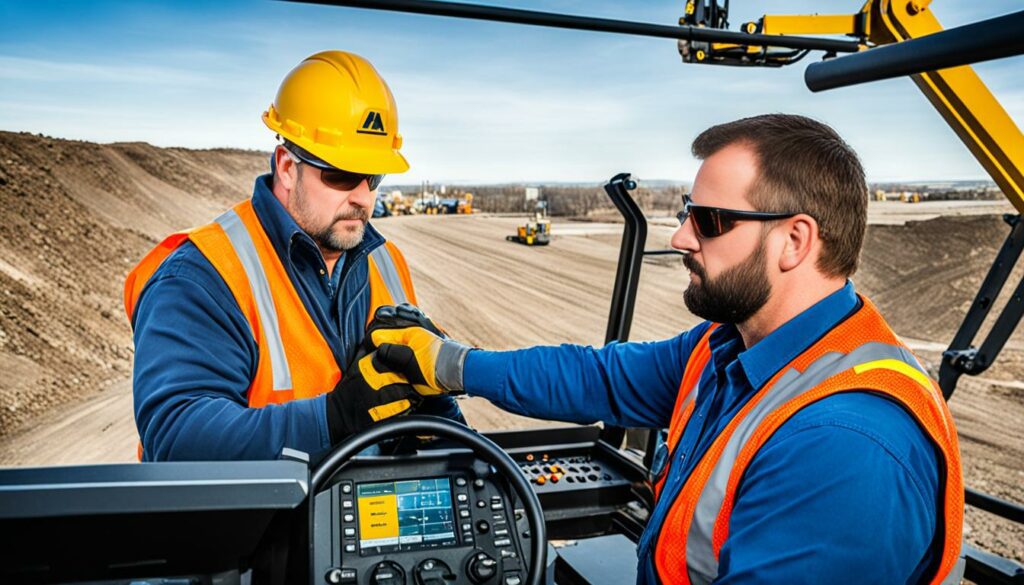
They use signals to communicate, like hand signs and radios. This lets them warn operators about dangers. Also, it helps the machines move smoothly, with everyone well-informed.
Having buffer zones around work areas adds another layer of safety. In North Dakota, for example, these zones keep others away, preventing accidents.
“Having a spotter available for each piece of heavy equipment in a busy construction zone can improve safety by providing clearances and safe operation guidance.”
Knowing about blind spots is key. Dump trucks, for example, have a large blind spot behind them. This shows why spotters are so important for safety.
They help avoid accidents like backovers. These are a top cause of heavy machinery accidents.
| Incident Type | Percentage of Accidents | Role of Spotters |
|---|---|---|
| Backover | 70% | Prevention |
| Crushing | 20% | Monitoring Blind Spots |
| Property Damage | 10% | Effective Communication |
Spotters also make sure operators are fit to work. They check that operators aren’t tired or affected by drugs. This keeps everyone safer.
In the construction sector, it’s crucial to avoid struck-by and caught-in/between accidents. 75% of fatalities come from being hit by heavy machinery. This includes items like cranes and trucks. Knowing the dangers and using the right safety steps can lower deaths and injuries.
Accidents where people get struck by something else are top for worker’s injuries. They are also second for deaths in construction. Shockingly, a quarter of these vehicle-related deaths are construction workers. This is more than any other job type. Such incidents involve falling or thrown items, machinery, and clashes with vehicles.
One out of ten deaths in construction zones are from incidents involving vehicles and workers. This shows that being alert to dangers is extremely important.
To reduce these risks, we must follow various tips concerning heavy machinery:
A clean work area is essential for safety. A neat place has less risk of accidents. Also, regular safety checks find and fix hazards before they cause harm, making work safer.
| Safety Measure | Impact on Safety |
|---|---|
| Regular Safety Training | Prevents incidents by increasing hazard awareness and preparedness. |
| Safe Work Procedures | Mitigates risks by ensuring clear, predictable actions. |
| Equipment Maintenance | Prevents malfunctions that could lead to struck-by incidents. |
| Clean Worksite | Reduces obstacles and hazards, improving overall safety. |
| Safety Audits | Identify potential hazards for proactive mitigation. |
Keeping heavy machinery safe to use is a big job. It needs a mix of good training and knowledge with lots of hands-on practice. This way, the people using the machines know what they’re doing. They should always keep learning and improving their skills.
It’s crucial to know all about the machines, like their load limits and how fast they can go. This info helps stop accidents. Each job should start with a close look at the machines and the area they’ll work in. Making checklists for this, and keeping them updated, helps ensure everything’s working as it should.
Following the right steps when using machines is key. This includes setting them up as advised and knowing what to do in an emergency. Wearing the right safety gear also makes a big difference, especially if things fall or fly around.
To make sure everyone stays safe, avoid distractions when machines are running. Things like talking on the phone or loud music can be really dangerous. Always use the safety tools the machines have, like the stop buttons, alarms, and seat belts. Keeping the machines well-maintained is also very important. It helps avoid problems and keeps everyone safe.
If something doesn’t seem right, speak up or fix it immediately. This helps make sure the job area is always safe. Everyone, not just machine operators, should watch out and be careful.
Good planning, always being alert, and talking to each other are the keys to safe machine use. By sticking to safety rules, we can have a workplace where accidents don’t happen. This keeps everyone working there safe and happy.
Safe operation of heavy machinery starts with proper training. This includes detailed planning and constant checks. Always follow safety steps like wearing a seatbelt and using PPE. This keeps the work area safe.
Training gives operators the skills needed to work safely. It helps them know how to use the machinery and spot dangers. Regular training keeps their skills sharp and helps avoid accidents.
Before use, check the machine for signs of wear and fluid levels. Make sure all safety parts work well. Operating only properly checked machines prevent accidents.
Operators must always be alert and watch out for risks. They use spotters and clear communication to understand the area better. This keeps everyone safe.
Lockout/tagout ensures equipment can’t start accidentally. It keeps workers safe during maintenance. This procedure is key to avoiding injuries.
Good communication, like using radios and hand signals, is vital. It helps workers understand each other and stay safe. This reduces the risks of accidents.
Using equipment as the manufacturer says makes sure it’s safe. Misusing it can cause accidents. This keeps the workplace safer.
To avoid these accidents, do risk checks and communicate clearly. Keep away from moving machinery and mark safe areas. Being alert and working with spotters reduces the danger.
PPE is vital for protection. It includes gloves, hard hats, and more. These items guard against injuries, making the site safer for everyone.
Planning safe paths is key to avoid accidents, especially with moving machinery. It includes marking restricted areas and safe routes. This planning makes the site safer.